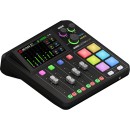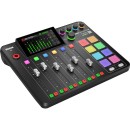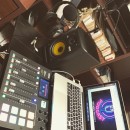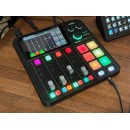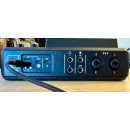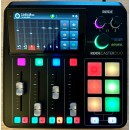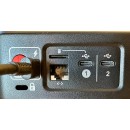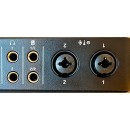RODECaster Duo vs. RODECaster Pro II: Which Integrated Audio Production Studio is Right for You?
The RODECaster Pro II is an evolution of the original RODECaster Pro, designed with podcasters, streamers, and content creators in mind. It boasts a powerful quad-core audio engine, high-gain Revolution Preamps, and advanced APHEX audio processing, providing pristine audio quality. The device features multiple channels, including four high-quality microphone inputs, six customizable smart pads, and Bluetooth connectivity for wireless audio input. Its intuitive interface, combined with a large touchscreen, makes it user-friendly. This model also includes multi-track recording capabilities, allowing users to save individual audio tracks for post-production, which is essential for professional-grade content creation.
On the other hand, the RODECaster Duo is a more compact version of its predecessor, maintaining most of the advanced features of the Pro II but in a smaller form factor. It is tailored for creators who need a portable yet powerful solution. The Duo includes two high-quality microphone inputs and four smart pads, making it ideal for solo or two-person operations. It retains the same quad-core processing power and Revolution Preamps, ensuring that the audio quality is not compromised despite the smaller size. The Duo is perfect for creators who are often on the move or have limited desk space but still require professional-grade audio production capabilities.
In summary, both the RODECaster Pro II and the RODECaster Duo offer top-tier audio production features, with the Pro II being suited for larger, more complex setups and the Duo catering to portable or smaller-scale productions. The choice between the two will largely depend on the scale of your projects and your need for mobility versus a more extensive range of inputs and controls.
In-Depth Specifications and Features Comparison
| User Rating Based on Analysis of Reviews | |
|---|---|
|
Show More |
| Pros: | |
|---|---|
|
|
| Cons: | |
|---|---|
|
|
| Key Specs | |
|---|---|
| Channels of I/O | |
| 2 Inputs / 4 Outputs |
Analog: 4 Inputs / 4 Outputs |
| Built-In DSP | |
| Yes | Yes |
| Maximum Sampling Rate | |
| 48 kHz / 24-Bit | 48 kHz / 24-Bit |
| Number of Microphone Inputs | |
| 2 | 4 Preamps |
| Number of Headphone Mixes | |
| 1x Master | 4x Assignable with Mix-Minus |
| Analog Audio I/O | |
| 2x Combo XLR-1/4" TRS Mic/Line Input 2x 1/4" TRS Line Output 2x 1/4" TRS Headphone Output |
4x Combo XLR-1/4" TRS Balanced/Unbalanced Mic/Line/Hi-Z Input 2x 1/4" TRS Balanced Line Output 4x 1/4" TRS Unbalanced Headphone Output |
| Host Connection | |
| 2x USB-C | 2x USB-C |
| OS Compatibility | |
| macOS Windows |
macOS 10.15 or Later Windows 10.1803 or Later Windows 11 iPadOS |
| Power Requirements | |
| AC/DC Power Adapter (Included) | AC/DC Power Adapter (Included) or USB Bus Power |
The RODECaster Pro II offers a more extensive set of capabilities compared to the RODECaster Duo. It features 4 channels of input and 4 channels of output, with built-in DSP and a maximum sampling rate of 48 kHz at 24-bit. It provides 4 microphone preamps and input level adjustments through 6 faders. The Pro II also supports 4 assignable headphone mixes with mix-minus functionality and includes a comprehensive analog audio I/O setup with 4 combo XLR-1/4" TRS balanced/unbalanced mic/line/Hi-Z inputs, 2 balanced line outputs, and 4 unbalanced headphone outputs. Connectivity is facilitated through 2 USB-C host connections, and it is compatible with macOS 10.15 or later, Windows 10.1803 or later, Windows 11, and iPadOS. Power is supplied via an AC/DC power adapter or USB bus power.
On the other hand, the RODECaster Duo is a more compact and streamlined option, featuring 2 channels of input and 4 channels of output, with the same built-in DSP and a maximum sampling rate of 48 kHz at 24-bit. It includes 2 microphone preamps and supports only 1 master headphone mix. Its analog audio I/O consists of 2 combo XLR-1/4" TRS mic/line inputs, 2 line outputs, and 2 headphone outputs. Like the Pro II, the Duo uses 2 USB-C host connections and is compatible with macOS and Windows. Power is also supplied via an included AC/DC power adapter.
In summary, the RODECaster Pro II is designed for more complex and versatile audio production with multiple input channels, more headphone mixes, and extensive I/O options, making it suitable for larger setups or more intricate productions. The RODECaster Duo, while still powerful, is tailored for simpler, more straightforward applications, ideal for smaller setups or users who require fewer input channels and headphone mixes.
| General | |
|---|---|
| Channels of I/O | |
| 2 Inputs / 4 Outputs |
Analog: 4 Inputs / 4 Outputs |
| Built-In DSP | |
| Yes | Yes |
| Maximum Sampling Rate | |
| 48 kHz / 24-Bit | 48 kHz / 24-Bit |
| Number of Microphone Inputs | |
| 2 | 4 Preamps |
| Built-In Microphone | |
| Number of Headphone Mixes | |
| 1x Master | 4x Assignable with Mix-Minus |
The RODECaster Pro II supports a higher number of channels with 4 analog inputs and 4 outputs. It features 4 high-quality preamps for microphone inputs, making it suitable for more complex setups requiring multiple microphone sources. Additionally, it boasts 6 faders to adjust input levels, providing more granular control over the audio mix. The Pro II also allows for 4 assignable headphone mixes with mix-minus, accommodating individual monitoring preferences for multiple users simultaneously.
In contrast, the RODECaster Duo is more streamlined with 2 analog inputs and 4 outputs. It supports 2 microphone inputs, which is ideal for smaller setups or simpler production environments. Unlike the Pro II, the Duo does not include expansion slots, reflecting its design for straightforward use cases. The Duo features 1 master headphone mix, which simplifies the monitoring process but does not offer the same level of individualized control as the Pro II.
Both models feature built-in DSP and support a maximum sampling rate of 48 kHz / 24-bit, ensuring high-quality audio processing. Neither unit has a built-in microphone, maintaining the focus on external mic use. However, the Pro II's additional features make it more versatile for complex productions, while the Duo offers a more compact and efficient solution for simpler audio production needs.
| Signal Processing | |
|---|---|
| Pad | |
| Gain/Trim Range | |
| -135 +76 dB | 0 to 76 dB |
| Solo/Mute | |
| Solo, Mute per Input Channel | Solo-in-Place/AFL, Mute, PFL per Input Channel |
The RODECaster Pro II does not include a pad feature and offers a gain/trim range from 0 to 76 dB. It provides extensive solo/mute options with Solo-in-Place/AFL, Mute, and PFL available per input channel. This flexibility allows for detailed control over individual channels, making it suitable for complex audio production environments where precise channel management is crucial.
In contrast, the RODECaster Duo also lacks a pad feature but has a broader gain/trim range from -135 to +76 dB. This wider range can accommodate a greater variety of input signals, potentially offering more versatility in handling different audio sources. However, it lacks a high-pass filter option, which might limit its capability to manage low-frequency noise directly. The solo/mute functionalities on the Duo are slightly more limited, offering only Solo and Mute per input channel without the additional PFL or AFL options found in the Pro II.
In summary, the RODECaster Pro II provides more advanced solo/mute options and a standard gain/trim range suitable for detailed audio production tasks, whereas the RODECaster Duo offers a wider gain/trim range but with more basic solo/mute functionalities and no high-pass filter.
| Connectivity | |
|---|---|
| Analog Audio I/O | |
| 2x Combo XLR-1/4" TRS Mic/Line Input 2x 1/4" TRS Line Output 2x 1/4" TRS Headphone Output |
4x Combo XLR-1/4" TRS Balanced/Unbalanced Mic/Line/Hi-Z Input 2x 1/4" TRS Balanced Line Output 4x 1/4" TRS Unbalanced Headphone Output |
| Phantom Power | |
| Yes | 48 V, Selectable On/Off |
| Digital Audio I/O | |
| Host Connection | |
| 2x USB-C | 2x USB-C |
| Host Connection Protocol | |
| USB 3.0 / 3.1/3.2 Gen 1 | USB 3.0 / 3.1/3.2 Gen 1 |
| USB (Non-Host) | |
| MIDI I/O | |
| Wireless | |
| Bluetooth *Built-In |
Wi-Fi / Bluetooth |
The RODE RODECaster Pro II offers a more extensive range of analog audio I/O options, featuring 4x Combo XLR-1/4" TRS Balanced/Unbalanced Mic/Line/Hi-Z Inputs, which allows for more versatility in connecting various types of microphones and instruments. It also includes 2x 1/4" TRS Balanced Line Outputs and 4x 1/4" TRS Unbalanced Headphone Outputs, which provide ample connectivity for monitoring and output. Moreover, it supports phantom power at 48 V, which is selectable on/off, making it suitable for powering condenser microphones.
On the other hand, the RODE RODECaster Duo is designed with a more streamlined approach, featuring 2x Combo XLR-1/4" TRS Mic/Line Inputs, 2x 1/4" TRS Line Outputs, and 2x 1/4" TRS Headphone Outputs. This setup is less extensive than the Pro II, making it more suited for simpler setups or smaller scale productions. Notably, the Duo does not support phantom power, which limits its compatibility with certain types of microphones, specifically condenser mics that require external power.
Both models share similar digital audio I/O features, as neither includes digital audio I/O or MIDI I/O capabilities. They both use 2x USB-C for host connections with protocols of USB 3.0 / 3.1/3.2 Gen 1, ensuring modern connectivity standards. Neither device has additional USB (Non-Host) or Sync I/O capabilities.
In terms of wireless connectivity, the RODECaster Pro II includes both Wi-Fi and Bluetooth, providing flexible options for wireless audio streaming and control. The RODECaster Duo, while also supporting Bluetooth, does not mention Wi-Fi, which might limit its wireless connectivity options in comparison to the Pro II.
Overall, the RODE RODECaster Pro II is more feature-rich and suitable for more complex audio production environments, while the RODE RODECaster Duo offers a more basic, streamlined setup ideal for simpler or smaller-scale productions.
| Digital Audio | |
|---|---|
| Sample Rates | |
| 48 kHz | 48 kHz |
| Bit Depths | |
| 24-Bit | 24-Bit |
However, a significant difference between the two models is the presence of sync sources. The RODE RODECaster Duo does not support sync sources, which may limit its ability to integrate with other digital audio equipment that requires synchronization. This feature might be crucial for users who need to align their audio production with other digital media or external devices, making the RODE RODECaster Pro II potentially more attractive for complex production environments where sync sources are necessary.
In summary, while both the RODE RODECaster Pro II and the RODE RODECaster Duo offer high-quality audio specifications with a sample rate of 48 kHz and a bit depth of 24-bit, the Pro II model provides additional functionality with the inclusion of sync sources. This difference may influence the choice of device depending on the specific needs and context of the user's audio production setup.
| Audio Storage & Playback |
|---|
| Compatibility | |
|---|---|
| OS Compatibility | |
| macOS Windows |
macOS 10.15 or Later Windows 10.1803 or Later Windows 11 iPadOS |
| Mobile App Compatible | |
| Mobile Device Compatibility | |
| iPad | |
Regarding OS compatibility, the RODECaster Pro II supports macOS 10.15 or later, Windows 10.1803 or later, and Windows 11, as well as iPadOS. On the other hand, the RODECaster Duo has a broader but less specific OS compatibility, simply listing macOS and Windows without specifying particular versions. This could imply broader or less defined support for various versions within these operating systems.
In terms of included software, the RODECaster Pro II does not come with any bundled software. The specifications for the RODECaster Duo do not mention any included software either, indicating that like the Pro II, it may also not come with additional software.
When it comes to mobile device compatibility, the RODECaster Pro II has specific support for iPads, indicating a more defined and perhaps optimized integration with Apple’s tablet devices. Conversely, the RODECaster Duo does not list any mobile device compatibility, which suggests it might not be optimized for use with mobile devices or does not officially support them.
In summary, while both the RODECaster Pro II and the RODECaster Duo serve as integrated audio production studios, they exhibit differences in OS compatibility, with the Pro II providing more detailed specifications. Neither product includes software, and only the Pro II specifies compatibility with mobile devices, particularly iPads.
| Power | |
|---|---|
| Power Requirements | |
| AC/DC Power Adapter (Included) | AC/DC Power Adapter (Included) or USB Bus Power |
| AC/DC Power Adapter | |
| 5 V | 15 VDC at 2 A (Included) |
The RODE RODECaster Pro II operates using an AC/DC power adapter that is included with the unit. The adapter provides 15 VDC at 2 A, which is a relatively higher power requirement, indicating that the Pro II is designed to handle more demanding audio production tasks that may require additional power.
In contrast, the RODE RODECaster Duo also comes with an included AC/DC power adapter, but it operates at a significantly lower power requirement of 5 V. This suggests that the Duo is optimized for lower power consumption, potentially making it more suitable for less intensive audio production tasks or for users who prioritize energy efficiency.
Additionally, the RODECaster Pro II has the capability to be powered via USB bus power, offering flexibility for mobile or on-the-go setups where a traditional power outlet may not be available. This feature is not mentioned for the RODECaster Duo, implying that it relies solely on its AC/DC power adapter for operation.
In conclusion, the RODECaster Pro II demands a higher power input and offers USB bus power functionality, making it a robust option for intensive audio production environments. On the other hand, the RODECaster Duo's lower power requirement suggests a focus on efficiency and possibly a more streamlined set of features.
| Physical | |
|---|---|
| Dimensions | |
| 9.3 x 8.9 x 3" / 235 x 225 x 76 mm | 12.2 x 10.7 x 3.3" / 30.9 x 27.3 x 8.3 cm |
| Weight | |
| 2.5 lb / 1131.0 g | 4.4 lb / 2.0 kg |
The RODE RODECaster Pro II is larger and heavier, with dimensions of 12.2 x 10.7 x 3.3 inches (30.9 x 27.3 x 8.3 cm) and a weight of 4.4 pounds (2.0 kg). This makes it a more substantial piece of equipment, which might be suitable for more permanent studio setups where space and portability are less of a concern.
On the other hand, the RODE RODECaster Duo is more compact and lighter, measuring 9.3 x 8.9 x 3 inches (235 x 225 x 76 mm) and weighing 2.5 pounds (1131.0 g). This reduced size and weight make it a more portable option, ideal for users who need to move their equipment frequently or who are working in smaller spaces.
In summary, the RODECaster Pro II offers a more robust physical presence, while the RODECaster Duo provides a lighter and more compact alternative, catering to different needs and preferences in terms of physical footprint and portability.
| Packaging Info | |
|---|---|
| Package Weight | |
| 4.58 lb | 7.02 lb |
| Box Dimensions (LxWxH) | |
| 10.8 x 10.3 x 4.8" | 12.9 x 11.9 x 5.6" |
In comparison, the RODECaster Duo is more compact and lighter, with a package weight of 4.58 lb. The box dimensions for the RODECaster Duo are 10.8 x 10.3 x 4.8 inches. This smaller form factor makes it more portable and easier to integrate into tight setups.
Both devices are designed to meet the needs of audio professionals, but the RODECaster Duo's lighter weight and smaller size could be advantageous for users who prioritize portability and space efficiency. Meanwhile, the RODECaster Pro II's larger dimensions might suggest more extensive onboard features or a more robust build, catering to users seeking a more comprehensive stationary setup.
| Customer Images | |
|---|---|
| Videos | |
|---|---|
|
|
|
